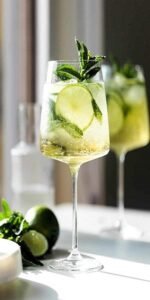The origins of the Hugo Spritz trace back to 2005. A bartender Roland Gruber crafted this delightful concoction in the quaint Italian town of Naturno, nestled along the Italian-Austrian border. Since then, its popularity has soared, spreading beyond its place of origin to neighboring countries such as Austria and Germany.
What sets the Hugo Spritz apart is its elegant balance of flavors – the floral notes from the St-Germain elderflower liqueur complement the natural lemon and citrus tones of the prosecco, creating a harmonious and refreshing taste profile. The addition of mint adds a cooling finish to the drink, further enhancing its appeal, especially during the warmer months.
The Hugo Spritz: Crafting a Refreshing Symphony of Flavors
Fresh mint is essential to accentuate the floral essence of the St-Germain, contributing a refreshing and vibrant touch to the cocktail. Combine it with the effervescence of bubbly prosecco and sparkling water, along with the zesty addition of fresh lime for a harmonious blend of flavors. If limes aren’t available, sliced lemons serve as an excellent alternative, offering a similar citrusy brightness.
Prosecco, characterized by its dry profile and nuanced flavors of green apple, honeysuckle, and pear, perfectly complements the bold acidity of lime and the aromatic mint. Its delicate nature ensures that the floral notes of St-Germain remain prominent, providing a sophisticated and balanced taste profile. In the absence of prosecco, Champagne can be used as a substitute, offering a comparable level of elegance and effervescence.
In summary, the Hugo Spritz is a testament to the ingenuity of its inventor and the timeless allure of Italian-inspired cocktails. With its simple yet sophisticated preparation and delightful flavor profile, it’s no wonder that this lower-alcohol sparkling cocktail has become a beloved favorite among cocktail enthusiasts worldwide.
The Hugo Spritz, a regional signature hailing from the South Tyrol province of Northern Italy, nestled amid the Dolomite mountain range, offers a delightful twist on the traditional Italian spritz. Unlike its counterparts, such as the Aperol Spritz or Campari Spritz, which feature bitter liqueurs as their base, the Hugo Spritz swaps out the bitterness for a refreshing floral note provided by elderflower.

Ingredients of Hugo Spitz:
The Hugo Spritz, a regional signature hailing from the South Tyrol province of Northern Italy, nestled amid the Dolomite mountain range, offers a delightful twist on the traditional Italian spritz. Unlike its counterparts, such as the Aperol Spritz or Campari Spritz, which feature bitter liqueurs as their base, the Hugo Spritz swaps out the bitterness for a refreshing floral note provided by elderflower.
To craft this modern classic Hugo Spritz, you’ll need the following ingredients:
- 1/2 ounce St-Germain elderflower liqueur
- 1 sprig of mint
- 4 ounces chilled prosecco
- 1 ounce chilled soda water
- Mint sprig and lemon wheel for garnish
Method of preparation of Hugo Spritz:
- Start by adding the St-Germain elderflower liqueur and a sprig of mint into a wine glass. Gently muddle the mint and St-Germain, allowing the flavors to infuse for about 3 minutes. Then, add ice to the glass, followed by the chilled prosecco and soda water. Stir briefly and gently to combine all the ingredients.
- To garnish, adorn the cocktail with a fresh mint sprig and a lemon wheel. For a visually appealing presentation, consider giving the mint a firm slap on the back of your hand or palm before garnishing to release its aromatic oils. This step enhances the overall drinking experience by imparting a burst of minty freshness with each sip.
- When preparing mint for garnish, strip the lower leaves from the stalk, leaving a neat bouquet at the top. Remember to shock the mint in an ice water bath before using to keep it looking fresh and vibrant.
Tip
A helpful tip from the test kitchen: Before adding mint to your cocktail, give it a gentle crush or firm slap on the back of your hand. This action releases the oils in the mint, intensifying its flavor and enhancing the overall taste experience of your drink.
Nutritional Information of some key ingredients used in Hugo Spritz:
Nutritionally, the Hugo Spritz offers a light and refreshing option, with each serving providing approximately 200 calories and 18 grams of carbohydrates. This analysis serves as an estimate based on the ingredients used and the preparation method.
To enjoy the Hugo Spritz at its finest, savor it on a sunny afternoon or as a prelude to a leisurely evening gathering. Whether you’re lounging on a patio or hosting a soirée, this refreshing libation is sure to elevate any occasion with its effervescent charm and floral elegance. Cheers to the art of mixology and the joy of discovering new culinary delights!
Per serving
Calories 200
Carbohydrates 18 g
Sodium 10 mg
Sugar 17 g
This analysis is an estimate based on available ingredients and this preparation. It should not substitute for a dietitian’s or nutritionist’s advice.
Also visit for more recipes
Frequently Asked Questions:
- What is a spritz?
A spritz is a wine-based cocktail typically made with sparkling wine, such as prosecco, a bitter liqueur like Aperol or Campari, and soda water. It often includes garnishes like fresh herbs or sliced citrus fruit.
- What kind of alcohol is St-Germain?
St-Germain is a French liqueur crafted with elderflowers. Each bottle of St-Germain reportedly contains the essence of 1,000 elderflower blooms.
